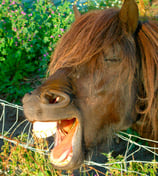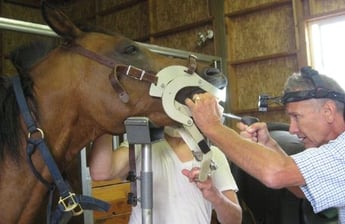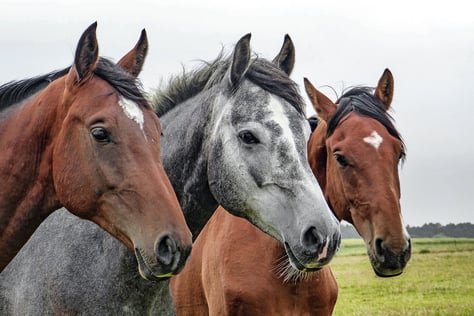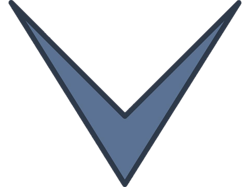 Equine teeth are designed to wear against the tooth above or below as the horse chews, thus preventing excess growth. The upper jaw is wider than the lower one. In some cases, sharp edges can occur on the outside of the upper molars and the inside of the lower molars, as they are unopposed by an opposite grinding surface. These sharp edges can reduce chewing efficiency of the teeth, interfere with jaw motion, and in extreme cases can cut the tongue or cheek, making eating and riding painful.
Equine teeth are designed to wear against the tooth above or below as the horse chews, thus preventing excess growth. The upper jaw is wider than the lower one. In some cases, sharp edges can occur on the outside of the upper molars and the inside of the lower molars, as they are unopposed by an opposite grinding surface. These sharp edges can reduce chewing efficiency of the teeth, interfere with jaw motion, and in extreme cases can cut the tongue or cheek, making eating and riding painful.
In the wild, a horse’s food supply allowed their teeth to wear evenly. But with domesticated horses grazing on lush, soft forage and a large number being fed grain or other concentrated feed, natural wear may be reduced. Equine dentistry can be undertaken by a vet or by a trained specialist such as an equine dental technician, or in some cases is performed by lay persons, including owners or trainers. Regular checks by a professional are normally recommended every six months or at least annually.
Many horses require floating (or rasping) of teeth once every 12 months, although this, too, is variable and dependent on the individual horse. The first four or five years of a horse's life are when the most growth-related changes occur and hence frequent checkups may prevent problems from developing. Equine teeth get harder as the horse gets older and may not have rapid changes during the prime adult years of life, but as horses become aged, particularly from the late teens on, additional changes in incisor angle and other molar growth patterns often necessitate frequent care. Once a horse is in its late 20s or early 30s, molar loss becomes a concern. Floating involves a veterinarian wearing down the surface of the teeth, usually to remove sharp points or to balance out the mouth. 
Problems with dentition for horses in work can result in poor performance or behavioral issues. The wear of the teeth can cause problems if it is uneven, with sharp points appearing, especially on the outer edge of the molars, the inner edge of the premolars and the posterior end of the last molars on the bottom jaw.
Other specific conditions relating to wear include a "step mouth", where one molar or premolar grows longer than the others in that jaw, normally because the corresponding tooth in the opposite jaw is missing or broken, and therefore could not wear down its opposite, a "wave mouth", where at least two molars or premolars are higher than the others, so that, when viewed from the side, the grinding surfaces produce a wave-like pattern rather than a straight line, leading to periodontal disease and excessive wear of some of the teeth, and a "shear mouth" when the grinding surfaces of the molars or premolars are severely sloped on each individual tooth (so the inner side of the teeth are much higher or lower than the outer side of the teeth), severely affecting chewing.
Horses may also experience an overbite/brachygnathism (parrot mouth), or an underbite/prognathism (sow mouth, monkey mouth). These may affect how the incisors wear. In severe cases, the horse's ability to graze may be affected. Horses also sometimes suffer from equine malocclusion where there is a misalignment between their upper and lower jaws.
The curvature of the incisors may also vary from the normal, straight bite. The curvature may be dorsal or ventral . These curvatures may be the result of an incisor malocclusion (e.g. ventral=overbite, dorsal=underbite). The curvature may also be diagonal, stemming from a wear pattern, offset incisors, or pain in the cheek teeth (rather than the incisors), which causes the horse to chew in one direction over the other.
Other common problems include abscessed, loose, infected, or cracked teeth, retained deciduous teeth, and plaque build-up. Wolf teeth may also cause problems, and are many times removed, as are retained caps.
Good dental care can not only eliminate these problems, but can help your horse lead a longer, healthier life.



